Themed collection Frontiers in Radionuclide Imaging and Therapy

Frontiers in radionuclide imaging and therapy, a chemical journey from naturally radioactive elements to targeted theranostic agents
Welcome to this themed issue of Dalton Transactions entitled: ‘Frontiers in Radionuclide Imaging and Therapy; A chemical journey from naturally radioactive elements to targeted theranostic agents’.

Dalton Trans., 2017,46, 14433-14434
https://doi.org/10.1039/C7DT90181J
Peptide-based fibrin-targeting probes for thrombus imaging
Herein we provide an overview of peptide-based fibrin-targeted probes developed for molecular imaging of thrombosis by different modalities with particular emphasis for nuclear imaging techniques.
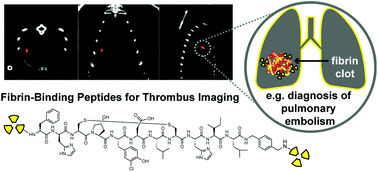
Dalton Trans., 2017,46, 14488-14508
https://doi.org/10.1039/C7DT02634J
Fluoroquinolones as imaging agents for bacterial infection
Three ways to radioactively label fluoroquinolones are available, thereby creating multiple options for developing a diagnostic for deep-seated bacterial infection.
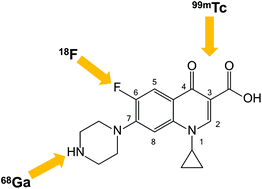
Dalton Trans., 2017,46, 14452-14460
https://doi.org/10.1039/C7DT01189J
Radionuclides in oncology clinical practice – review of the literature
Radionuclide therapy is a promising type of targeted therapy for cancer and its use is becoming more common in several types of malignant tumors.
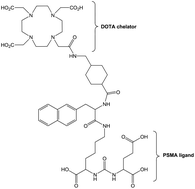
Dalton Trans., 2017,46, 14475-14487
https://doi.org/10.1039/C7DT01929G
Metal complexes for multimodal imaging of misfolded protein-related diseases
Aggregation of misfolded proteins and progressive polymerization of otherwise soluble proteins is a common hallmark of several highly debilitating and increasingly prevalent diseases, including amyotrophic lateral sclerosis, cerebral amyloid angiopathy, type II diabetes and Parkinson's, Huntington's and Alzheimer's diseases.
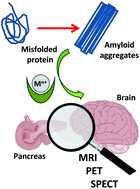
Dalton Trans., 2017,46, 14461-14474
https://doi.org/10.1039/C7DT02371E
Technetium-99m based small molecule radiopharmaceuticals and radiotracers targeting inflammation and infection
99mTc-labeled antibiotics, antifungal drugs, antimicrobial peptides and COX-2 inhibitors are comprehensively reviewed.
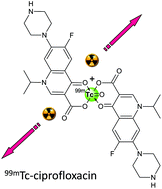
Dalton Trans., 2017,46, 14435-14451
https://doi.org/10.1039/C7DT01735A
99mTc-3Cboroxime: a novel 99mTc(III) complex [99mTcCl(CDO)(CDOH)2B-3C] (CDOH2 = cyclohexanedione dioxime; 3C-B(OH)2 = 3-(carbamoylphenyl)boronic acid) with high heart uptake and long myocardial retention
In this study, we found that 99mTc-3Cboroxime has the myocardial retention longer than that of 99mTc-Teboroxime, and its heart washout kinetics follows a regressive linear relationship over the 60 min period.
![Graphical abstract: 99mTc-3Cboroxime: a novel 99mTc(iii) complex [99mTcCl(CDO)(CDOH)2B-3C] (CDOH2 = cyclohexanedione dioxime; 3C-B(OH)2 = 3-(carbamoylphenyl)boronic acid) with high heart uptake and long myocardial retention](/en/Image/Get?imageInfo.ImageType=GA&imageInfo.ImageIdentifier.ManuscriptID=C7DT01292F&imageInfo.ImageIdentifier.Year=2017)
Dalton Trans., 2017,46, 14509-14518
https://doi.org/10.1039/C7DT01292F
[AlCl3(BnMe2-tacn)] – a new metal chelate scaffold for radiofluorination by Cl/F exchange
Radiofluorination of [AlCl3(BnMe2-tacn)] via a Cl/F exchange reaction is described, along with a cartridge-based purification method; the [Al18F19F2(BnMe2-tacn)] exhibits excellent stability (>99% RCP after 3 h).
![Graphical abstract: [AlCl3(BnMe2-tacn)] – a new metal chelate scaffold for radiofluorination by Cl/F exchange](/en/Image/Get?imageInfo.ImageType=GA&imageInfo.ImageIdentifier.ManuscriptID=C7DT02122D&imageInfo.ImageIdentifier.Year=2017)
Dalton Trans., 2017,46, 14519-14522
https://doi.org/10.1039/C7DT02122D
Manganese-52: applications in cell radiolabelling and liposomal nanomedicine PET imaging using oxine (8-hydroxyquinoline) as an ionophore
The ionophore 8-hydroxyquinoline (oxine) has been used to radiolabel cells and liposomal nanomedicines with the PET radiometal manganese-52.

Dalton Trans., 2018,47, 9283-9293
https://doi.org/10.1039/C8DT00100F
Chemistry and radiochemistry of As, Re and Rh isotopes relevant to radiopharmaceutical applications: high specific activity radionuclides for imaging and treatment
Advances in production, separation, target recovery, and chelation chemistry of high specific activity radionuclides will promote new theranostic agent development.
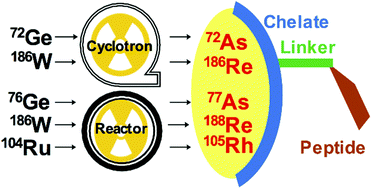
Dalton Trans., 2017,46, 14677-14690
https://doi.org/10.1039/C7DT02407J
Measurement of reaction kinetics of [177Lu]Lu-DOTA-TATE using a microfluidic system
Design and evaluation of a microfluidic system that allowed the determination of Arrhenius parameters for the formation of [177Lu]Lu-DOTA-TATE using clinical radiolabeling conditions.
![Graphical abstract: Measurement of reaction kinetics of [177Lu]Lu-DOTA-TATE using a microfluidic system](/en/Image/Get?imageInfo.ImageType=GA&imageInfo.ImageIdentifier.ManuscriptID=C7DT01830D&imageInfo.ImageIdentifier.Year=2017)
Dalton Trans., 2017,46, 14669-14676
https://doi.org/10.1039/C7DT01830D
H4octapa: synthesis, solution equilibria and complexes with useful radiopharmaceutical metal ions
H4octapa is synthesized and complexed to nine metals of medicinal interest. Crystal structures of the ligand and its La complex were obtained. Solution equilibria for the ligand and several lanthanide complexes were investigated.
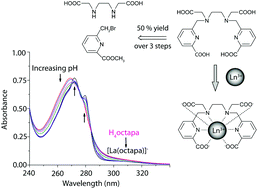
Dalton Trans., 2017,46, 14647-14658
https://doi.org/10.1039/C7DT02343J
Clinical evaluation of the radiolanthanide terbium-152: first-in-human PET/CT with 152Tb-DOTATOC
The existence of theragnostic pairs of radionuclides allows the preparation of radiopharmaceuticals for diagnostic and therapeutic purposes.
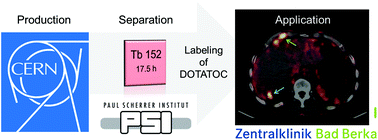
Dalton Trans., 2017,46, 14638-14646
https://doi.org/10.1039/C7DT01936J
MANOTA: a promising bifunctional chelating agent for copper-64 immunoPET
A comparison of four bifunctional chelating agents showed superior behaviour of a new NOTA derivative for 64Cu labelling of antibody fragments.

Dalton Trans., 2017,46, 14659-14668
https://doi.org/10.1039/C7DT01772C
Structure and reactivities of rhenium and technetium bis-arene sandwich complexes [M(η6-arene)2]+
Rhenium and 99Tc bis-arene complexes for a molecule-based theranostic approach are presented. Conjugation of biovectors to benzene or substitution of naphthalene allows integration of {Re(η6-C6H6)}+ in pharmaceutical lead structures.
![Graphical abstract: Structure and reactivities of rhenium and technetium bis-arene sandwich complexes [M(η6-arene)2]+](/en/Image/Get?imageInfo.ImageType=GA&imageInfo.ImageIdentifier.ManuscriptID=C7DT02072D&imageInfo.ImageIdentifier.Year=2017)
Dalton Trans., 2017,46, 14631-14637
https://doi.org/10.1039/C7DT02072D
Copper complexes with dissymmetrically substituted bis(thiosemicarbazone) ligands as a basis for PET radiopharmaceuticals: control of redox potential and lipophilicity
A library of copper(II) bis(thiosemicarbazone) complexes offers independently controlled redox potential and lipophilicity for optimal 64Cu PET tracer design.
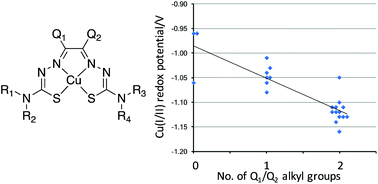
Dalton Trans., 2017,46, 14612-14630
https://doi.org/10.1039/C7DT02008B
Comparative studies on the therapeutic benefit of targeted α-particle radiation therapy for the treatment of disseminated intraperitoneal disease
Choosing an appropriate α-emitter for targeted therapy resides in multiple variables beyond efficacy such as the economics of injected dose.
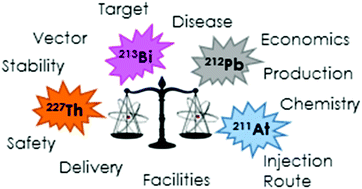
Dalton Trans., 2017,46, 14591-14601
https://doi.org/10.1039/C7DT01819C
In vitro and in vivo trackable titanocene-based complexes using optical imaging or SPECT
Two unprecedented titanocene-based theranostics have been synthesized, characterized, and tracked either in vitro (BODIPY probe) or in vivo (111In-DOTA probe).
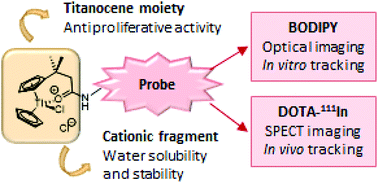
Dalton Trans., 2017,46, 14548-14555
https://doi.org/10.1039/C7DT01981E
Fast and cost-effective cyclotron production of 61Cu using a natZn liquid target: an opportunity for radiopharmaceutical production and R&D
Following our previous work on the production of radiometals, such as 64Cu and 68Ga, through the irradiation of liquid targets using a medical cyclotron, we describe in this paper a technique to produce 61Cu through the irradiation of natural zinc using a liquid target.
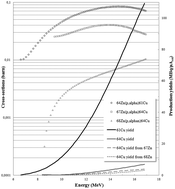
Dalton Trans., 2017,46, 14556-14560
https://doi.org/10.1039/C7DT01836C
Novel bifunctional DATA chelator for quick access to site-directed PET 68Ga-radiotracers: preclinical proof-of-principle with [Tyr3]octreotide
Comparison of 68Ga-DATA-TOC vs. 68Ga-DOTA-TOC in sst2-positive cells and tumor-bearing mice revealed the suitability of DATA for easy access to 68Ga-labeled vectors.
![Graphical abstract: Novel bifunctional DATA chelator for quick access to site-directed PET 68Ga-radiotracers: preclinical proof-of-principle with [Tyr3]octreotide](/en/Image/Get?imageInfo.ImageType=GA&imageInfo.ImageIdentifier.ManuscriptID=C7DT01684K&imageInfo.ImageIdentifier.Year=2017)
Dalton Trans., 2017,46, 14584-14590
https://doi.org/10.1039/C7DT01684K
Thiourea derivatives as chelating agents for bioconjugation of rhenium and technetium
A 99mTc complex with a tetradentate thiocarbamoylbenzamidine group was used for the conjugation of angiotensin-II. The resulting bioconjugate is stable in vivo and in vitro.
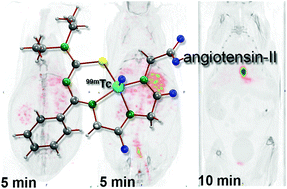
Dalton Trans., 2017,46, 14602-14611
https://doi.org/10.1039/C7DT01834G
Preparation of tetrazine-containing [2 + 1] complexes of 99mTc and in vivo targeting using bioorthogonal inverse electron demand Diels–Alder chemistry
A new 99mTc-labelled tetrazine for targeted imaging using bioorthogonal chemistry was developed and evaluated in vivo using a trans-cyclooctene derived bisphosphonate targeting regions of high bone turnover and bone lesions.
![Graphical abstract: Preparation of tetrazine-containing [2 + 1] complexes of 99mTc and in vivo targeting using bioorthogonal inverse electron demand Diels–Alder chemistry](/en/Image/Get?imageInfo.ImageType=GA&imageInfo.ImageIdentifier.ManuscriptID=C7DT01497J&imageInfo.ImageIdentifier.Year=2017)
Dalton Trans., 2017,46, 14691-14699
https://doi.org/10.1039/C7DT01497J
Technetium-99m complexes of L-arginine derivatives for targeting amino acid transporters
The metal complex Tc2 exhibits relevant internalization in several cancer cell lines, likely to be mediated by cationic amino acid transporters.
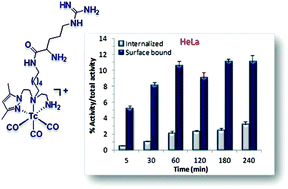
Dalton Trans., 2017,46, 14537-14547
https://doi.org/10.1039/C7DT01146F
Mangiferin functionalized radioactive gold nanoparticles (MGF-198AuNPs) in prostate tumor therapy: green nanotechnology for production, in vivo tumor retention and evaluation of therapeutic efficacy
We report here production of MGF-198AuNPs and its application for prostate tumor therapy.
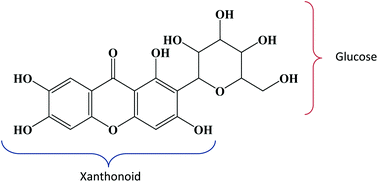
Dalton Trans., 2017,46, 14561-14571
https://doi.org/10.1039/C7DT00383H
In vitro/in vivo “peeling” of multilayered aminocarboxylate gold nanoparticles evidenced by a kinetically stable 99mTc-label
The BBN-Au-DTDTPA coating is selectively released upon interaction with glutathione (GSH), rendering this nanoplatform potentially useful for GSH-mediated drug delivery.
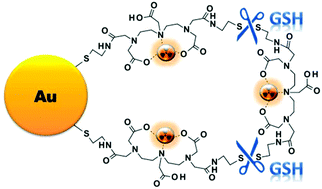
Dalton Trans., 2017,46, 14572-14583
https://doi.org/10.1039/C7DT00864C
Combining imaging and anticancer properties with new heterobimetallic Pt(II)/M(I) (M = Re, 99mTc) complexes
New metal-based anticancer agents with imaging, chemotherapeutic and photosensitizing properties.
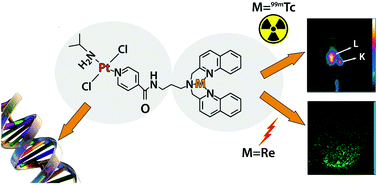
Dalton Trans., 2017,46, 14523-14536
https://doi.org/10.1039/C7DT00043J